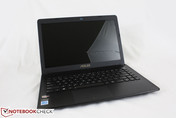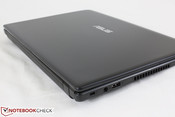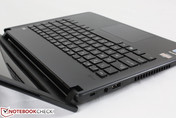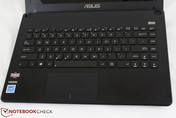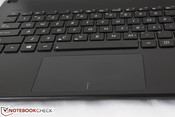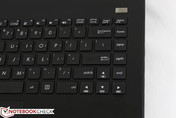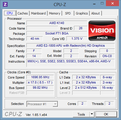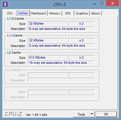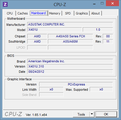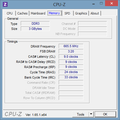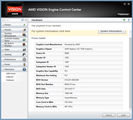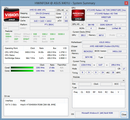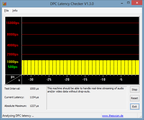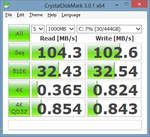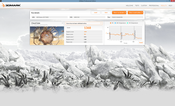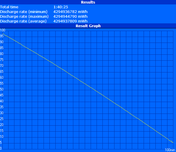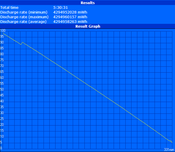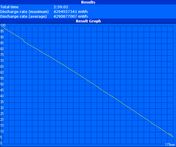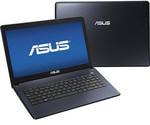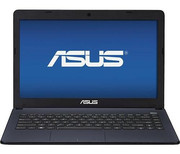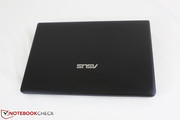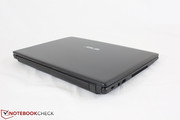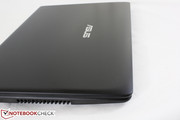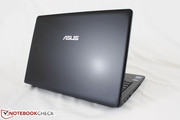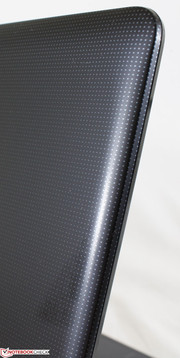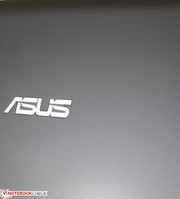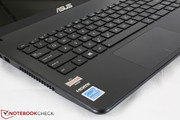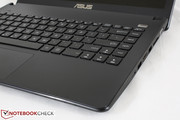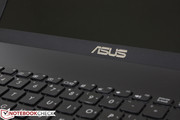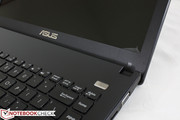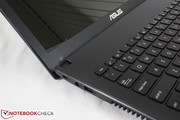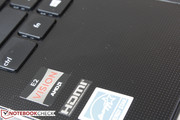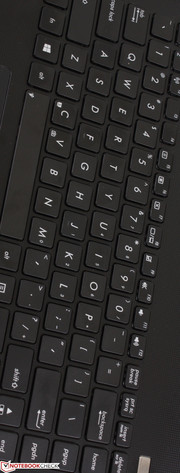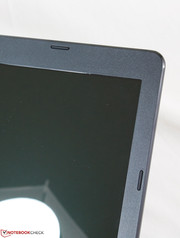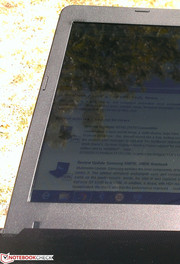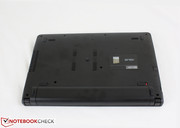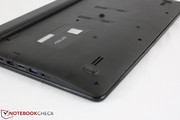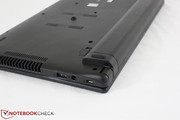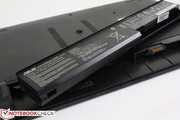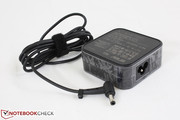Review Asus X401U-BE20602Z Notebook
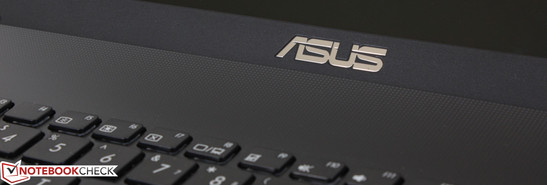
Revealed exactly one year ago at Computex 2012, the Asus X401 series was introduced to lead the manufacturer's budget lineup. The word "budget" is stressed here as the notebook starts at incredibly low prices, especially for a 14-inch offering.
The model in review is the Asus X401U-BE20602Z, a model equipped with a low-power AMD E2-1800 APU with integrated Radeon HD 7340 graphics, 4 GB single-channel RAM, 1366 x 768 resolution display and USB 3.0 connectivity for just $279. In short, the model can be considered a 14-inch netbook based on its core specifications. Competing 14-inch budget models like the Aspire V5-431, Vostro 3460 or ThinkPad Edge E335 retail much closer to $500 each in comparison. Understandably, corners have to be cut in order to shave hundreds off the price. We find out in this review where these sacrifices were made and if the notebook may be worth the relatively small investment.
Case
The all-plastic case looks attractive from afar with its dotted pattern design on its surfaces. The X401U is aesthetically no different from the 13.3-inch X301A. Look closer, however, and the cheap material becomes more obvious to the eye. The dotted pattern is simply printed on and textureless, leaving a smooth plastic feel across the lid and palm rests. The outer lid in particular depresses easily with applied pressure and so do the palm rests and the center of the keyboard. Side-to-side twisting of the base and lid fare a bit better in comparison and the tougher, slightly thicker underside saves the notebook from being too rickety. Fingerprints can and will accumulate everywhere quickly.
The overall thin chassis material allows the X401U to be very light. Compared to other budget 14-inch models like the ThinkPad Edge E335 (1.8 kg), Vostro 3460 (2.32 kg) and Aspire V5-431 (1.99 kg), the Asus is only 1.74 kg while being just a few millimeters thicker than the others. The hinges are also an improvement over the X301A and are quite taut to prevent against display vibrations when typing. Otherwise, construction is mediocre at best and behind both the Vostro 3460 and ThinkPad Edge.
Connectivity
The X401U houses all the major interfaces including dual video-out ports, both of which can be used simultaneously but only up to two active displays at a time. There are just two USB ports, however, only one of which is USB 3.0. The notebook also lacks an optical drive, something that both the 14-inch Aspire V5-431 and Vostro 3460 offer. The latter in particular offers twice the number of USB ports.
All ports are located on the left- and right-hand edges as the rear is reserved for the removable battery. The majority of the ports are located on the right edge which may be a disadvantage for right-handed users.
Communication
WLAN is provided by the half-mini PCI-e Ralink RT5390. The 1x1 single-band card is capable of a theoretical 150 mbps transfer rate and should be sufficient for home users. We ran into no random spikes or connectivity issues with the system wireless. There is no Bluetooth and no support for UMTS functionality.
Accessories
Beyond the 19 V power adapter and simple installation guide, the X401U includes no other accessories out-of-the-box. The lack of a dedicated docking port also limits the notebook to generic USB devices and other accessories. System Restore can be performed either under the built-in Windows 8 utility or through the Asus Installation Wizard.
Warranty
Asus includes a two-year limited international warranty that varies depending on the region, though all customers will benefit from a separate one-year battery warranty as well. The manufacturer's Premium Care package throws in additional damage protection and on-site service while users who choose to register their product online will receive update reminders and free WebStorage cloud space.
Input Devices
Keyboard
The Chiclet keyboard is made up of large and evenly spaced keys for easy typing without feeling too cramped. Though the layout and styling share visual similarities to the Asus ROG notebooks, the travel and feedback on the X401U are much lower and too light to the touch. The keys feel soft when pressed and are thus simply not satisfying during use. The Space bar in particular is horrid as it will sometimes not detect a clear input unless if the user hits the key directly at its center. The lack of any auxiliary keys will mean users must rely on fn key combinations for a number of system settings.
We can appreciate the full-size arrow keys that work quite well, especially compared to the sometimes cramped keys of other 14-inch models like the ThinkPad E335. The low travel, unresponsive Space bar and soft Enter key, however, are much more difficult to forgive.
Touchpad
The plastic touchpad is above average in size (10.5 x 6.25 cm) and performs as expected without any lags or hitches. With Asus Smart Gesture, the surface supports up to 3-finger inputs and other Windows 8-specific swipes. Two-finger scrolling is generally smooth and reliable, but other multi-touch functions like zooming feel slow and delayed. Still, the touchpad works well for basic pointing and clicking should an external mouse be unavailable.
The integrated left and right mouse clicks feel shallow in travel, but its feedback and loud auditory click are otherwise satisfying and reliable. Note that the downward force required to input a mouse click is larger than normal unless if the user clicks close to the very bottom edge of the touchpad. This can be inconvenient during use especially since it is easy to accidentally move the cursor instead of simply inputting a mouse click.
Display
Budget notebooks commonly sport 1366 x 768 resolution displays, so the X401U here shows no surprises. The glossy 14-inch panel is good for the price as it is clean and bright enough for indoor situations with only a small hint of the screen-door effect when up close. Users demanding higher 14-inch resolutions will have to look at much higher starting prices including the recently released ThinkPad T431s, Latitude 6430u or ProBook 6475b. Otherwise, the 768p display is suitable for browsing and word processing tasks.
With the X-Rite i1Pro Basic 2 spectrophotometer, an average brightness of about 189 nits was measured across nine quadrants, similar to both the Aspire V5 431 and ThinkPad Edge E335 while being brighter than the admittedly dim Vostro 3460. Contrast is middling but surprisingly good for a budget model at around 300:1, or noticeably higher than the sub 200:1 contrast ratios of the three competing models mentioned above.
| |||||||||||||||||||||||||
Brightness Distribution: 89 %
Center on Battery: 188.8 cd/m²
Contrast: 333:1 (Black: 0.567 cd/m²)
59% AdobeRGB 1998 (Argyll 1.6.3 3D)
62.8% AdobeRGB 1998 (Argyll 3D)
85.3% sRGB (Argyll 3D)
62.6% Display P3 (Argyll 3D)
Gamma: 2.51
CCT: 15538 K
Color space reproduction is again very good for a budget display. At roughly 80 percent of the sRGB spectrum, the display outclasses the IdeaPad S400, Aspire V5-431 and Vostro 3460, all of which are budget 14-inch offerings. The gamut range is still too low to satisfy professional users, however, and most office or home users will never notice or make use of the wider color space.
Color reproduction was analyzed further with the SpectraCal software. Here the average color temperature is very cool and above the typical 6500K baseline, leading to a bluish cast and grayscale. Colors are also generally inaccurate throughout all saturation levels with a DeltaE north of 10 units for the majority of colors. Again, such small inaccuracies are generally of no importance to the target home or office user.
The average 189 cd/m2 screen brightness on maximum settings is simply not enough to deter glare and reflections under outdoor conditions, especially for a glossy display. Outdoor use is straining to the eyes after some time and maximum brightness is highly recommended should it be unavoidable. Users will be tilting the screen for the best angle to reduce glare, which further limits outdoor usability. Fortunately, maximum brightness will not artificially decrease when running on batteries.
Viewing angle stability is typical of a standard TN panel. Side-to-side angles are acceptable, but colors quickly degrade if viewing from below the center normal. When combined with the relatively small screen size, comfortably sharing the display with multiple other viewers will be difficult. The narrow viewing window should not be a major issue for the sole user.
Performance
The X401U in review uses the AMD E2-1800 APU, an 18 Watt dual-core Zacate processor roughly equivalent to the older E-450 APU. Other X401U models sport Celeron, Pentium, and Core i3 options as unveiled by Asus, all of which have higher performance potentials than the AMD processor in use. Our system will idle at 850 MHz if under the Power Saver profile and will operate at its full 1.7 GHz frequency when under load.
The integrated Radeon HD 7340 GPU offers good performance in its category against older Intel Atom graphics solutions, but it is simply not up to par against more modern integrated GPUs and is even weaker than the now ancient Intel HD 3000 GPU as seen in our benchmarks below. In the X401U, the Radeon core will idle at 283.3 MHz and will operate at its full 523 MHz frequency with Turbo up to 680 MHz. For more information and benchmarks on the E2-1800, see our dedicated page here.
RAM is provided by a single-channel 4 GB module. Unfortunately, there is no easily accessible maintenance hatch underneath for quick access to the RAM, HDD and or other internal components.
Processor
Synthetic benchmarks place the E2-1800 in line with other notebooks sporting the same processor in our database, most notably the 14-inch ThinkPad Edge E335, 11.6-inch Edge E135 and 11.6-inch Vaio SVE-1111M1E/P. In other words, its raw performance is very slow compared to competing budget notebooks sporting Pentium processors. The Edge E130 and its Pentium 977, for example, returns CineBench R11.5 64-Bit multi-thread scores about 80 percent higher than the X401U in review. wPrime performance is equally unimpressive as the E2-1800 scores a difference within just a couple percentage points from the generations old Atom N550 and E-Series E-350.
System Performance
The final PCMark 7 score of 1199 points is one of the highest in our database for notebooks equipped with the same E2-1800 APU. The Vaio SVE-1111M1E/P, for example, only scores 965 points in the same benchmark. Nonetheless, a low-power Intel Core Haswell CPU like the Core-3217U in the recently reviewed AsusPro P56CB can score twice as high with the aid of an SSD cache. Similarly, the Toshiba Satellite C850 and its Celeron 1000M scores in the 2000 range without an SSD, much higher than the Asus in review. The X401U may be half the price, but performance is appropriately halved as well.
Subjectively, performance feels slow as applications open with a noticeable delay and navigation not as seamless for a less-than-smooth experience. The system's own Windows Experience Index reveals an imbalanced system due to weak processor.
| PCMark 7 Score | 1199 points | |
Help | ||
Storage Devices
The equipped 7 mm Hitachi Travelstar HTS545050A7E380 returns average results in both HD Tune and CDM. Its average transfer rate of 80 MB/s is mediocre, though this is to be expected from a slower SATA II 5400 RPM drive. The 5400 RPM Toshiba HDD in the Satellite C850, for example, returns very similar results in HD Tune, while other drives like the Western Digital in the Aspire V5 431 can top 90 MB/s. 7200 RPM drives like the Seagate in the Vostro 3460 can benefit greatly in both transfer rates and access times, the latter of which is very slow at 20 ms for the Asus X401U.
For more information and benchmarks, see our HDD and SSD list here.
Gaming Performance
The integrated Radeon HD 7340 is a low-end graphics card typically paired with a number of AMD Zacate class processors. In general, the GPU is slightly slower than the previous generation of Intel HD Graphics found on Ivy Bridge processors, which itself was made to perform below the more common Intel HD 3000 integrated GPU. As an example, the average Intel HD Graphics scores 11 percent higher in CineBench 11.5 64-Bit OpenGL, 2 percent lower in 3DMark 11 and over 25 percent higher in the latest 3DMark 2013 benchmarks compared to the Radeon HD 7340.
The poor performance in synthetic benchmarks is reflected in real-world gaming sessions. Newer titles like Tomb Raider are essentially unplayable, which barely reaches 20 FPS on average. Even Dishonored, which is in not generally known to be taxing on systems, is unplayable at its lowest settings. Users will be limited to Flash-type games and older, less intensive PC titles.
Furthermore, 1080p videos will suffer from noticeable frame drops. This may not be an issue for native 720p playback, but users who intend to use the E2-1800-equipped X401U for 1080p playback via an external monitor may be disappointed about the frame rate stutters.
| 3DMark 03 Standard | 6672 points | |
| 3DMark 06 Standard Score | 2360 points | |
| 3DMark Vantage P Result | 1028 points | |
| 3DMark 11 Performance | 357 points | |
| 3DMark Ice Storm Standard Score | 15281 points | |
| 3DMark Cloud Gate Standard Score | 1368 points | |
| 3DMark Fire Strike Score | 221 points | |
Help | ||
| low | med. | high | ultra | |
|---|---|---|---|---|
| Guild Wars 2 (2012) | 9 | 4 | ||
| Dishonored (2012) | 15 | 12 | 11 | |
| Tomb Raider (2013) | 19 | 10 | 7 | |
| StarCraft II: Heart of the Swarm (2013) | 43 | 15 | 9 |
Emissions
System Noise
Fan noise is noticeable at about 35 dB(A) even when idling compared to the low 30 dB(A) range of the Aspire V5-431. The notebook is slightly audible under typical ambient conditions, which is a bit disappointing considering the low-power CPU and performance of the system. The always active fan here is also similar in noise level to the Vostro 3460.
Under heavier loads, the notebook can reach up to 41 to 43 dB(A). HD playback will induce the higher fan noise, but fortunately not up to the 40 dB(A) range, so users need not worry about distracting fan noise in general. On the other hand, extended 3D gaming sessions and other CPU + GPU intensive tasks will push the system fan to its limits.
Noise level
| Idle |
| 35.7 / 35.8 / 35.9 dB(A) |
| Load |
| 41.2 / 43.9 dB(A) |
 | ||
30 dB silent 40 dB(A) audible 50 dB(A) loud |
||
min: | ||
Temperature
Idling surface temperatures are quite warm at about 30 degrees C on average (or about 5 degrees higher than ambient) on both the top and bottom surfaces. This is similar to the ThinkPad Edge E335 equipped with the same AMD APU.
Under higher loads, the palm rests and touchpad areas change little in temperature, if at all. This allows for comfortable hands during heavier sessions even after extended periods. Instead, much of the heat is concentrated on the hot spot nearest the vent, which can reach 43 to 44 degrees C. As a result, the left side of the notebook including the keyboard can feel much warmer than the right side. We did not find this to be an issue during use, but a flat surface is preferable nonetheless if gaming or for other intensive tasks. Compared to the Vostro 3460 and its standard voltage Core i5 CPU, the Asus runs much cooler on average.
(±) The maximum temperature on the upper side is 42.2 °C / 108 F, compared to the average of 33.1 °C / 92 F, ranging from 21.6 to 53.2 °C for the class Netbook.
(±) The bottom heats up to a maximum of 44.4 °C / 112 F, compared to the average of 36.6 °C / 98 F
(+) In idle usage, the average temperature for the upper side is 30.9 °C / 88 F, compared to the device average of 29.8 °C / 86 F.
(+) The palmrests and touchpad are cooler than skin temperature with a maximum of 31.2 °C / 88.2 F and are therefore cool to the touch.
(±) The average temperature of the palmrest area of similar devices was 29.3 °C / 84.7 F (-1.9 °C / -3.5 F).
Stress Test
We utilize Prime95 and FurMark to stress the system with HWiNFO, CPU-Z and GPU-Z as monitoring tools to observe for any potential throttling or stability issues. Note that HWiNFO reports the processor operating at 3.4 GHz, but fortunately CPU-Z reports correctly reports the CPU at 1.7 GHz.
With only Prime95 active to stress the CPU, both cores were observed to be operating at their rated 1.7 GHz maximum without any drops. Similarly with only FurMark active, the integrated GPU was observed to be operating at its maximum 680/667 MHz (core/memory) uninterrupted. When both Prime95 and FurMark were active, the CPU maintained its 1.7 GHz clock while the GPU throttled to its base 523.1/667 MHz. The core leveled out at about 84 degrees C after a full hour of maximum stress.
The drop in GPU speed fortunately has no ill effect on everyday performance. Running 3DMark 11 immediately following the stress test returned no statistically significant drops in final scores. Full performance is also offered while running on battery power as the same benchmark run resulted in the same final scores.
Speakers
The stereo speakers are located on the underside of the notebook with grilles facing directly towards the desk. Sound quality is slightly muffled but otherwise acceptable considering the size. We experienced no rattling or imbalances at higher volumes, though maximum volume is a bit on the low side. As expected, bass is lacking and hardly perceptible compared to the overemphasized midtones. Better results are achieved with external 3.5 mm audio solutions for higher quality music and video playback.
Battery Life
The 4400 mAh, 47 Wh user-removable Li-Ion battery ships with every model as no other sizes are available. This capacity is average for a notebook this size and is similar to the Vostro 3460 (48 Wh), larger than the Aspire V5-431 (37 Wh) and smaller than the ThinkPad Edge E335 (62.4 Wh). Perhaps unsurprisingly, the recorded WLAN runtimes between the three competing notebooks above are shortest with the Acer (~3 hours) and longest with the Lenovo (~5 hours).
Unfortunately, the X401U lies on the lower-end of the spectrum according to Battery Eater. While its idling runtime is respectable at over 5.5 hours, this was only achieved with wireless radios off and at the lowest possible brightness setting. Its more realistic WLAN runtime, which loops our script at 150 cd/m2 brightness to simulate typical browsing conditions until automatic shutdown, only lasted for 3 hours. As a result, users can expect up to about 4 hours of constant use out of the Asus depending on system settings and processing load. Though not terrible by any means, the X401U is certainly not fit for all-day outdoor use.
Verdict
The low price of under $280 for a lightweight 14-inch notebook is undeniably attractive and cut corners should be expected from any interested buyer. However, we cannot agree with the sacrifices made to the hardware. In particular, the unreliable Space bar is a real hindrance to general usage and the slow system performance can be felt with light-moderate multitasking. 1080p playback is not perfect and the lack of an accessible maintenance hatch makes upgrading the notebook more difficult than it should be. The portability and thinness of the design are let down by the weak outer lid and glare-heavy display unfit for extended outdoor use.
The budget ThinkPad Edge series will net users better quality hardware all-around and is a good alternative to the X401U. The same can be said for Dell's Vostro lineup or Asus's own VivoBook series as well, though these options will still cost users hundreds more than the very inexpensive X401U. Otherwise, the notebook is OK as a secondary solution primarily for browsing, email and other very light tasks similar to that of a tablet or smartphone.




